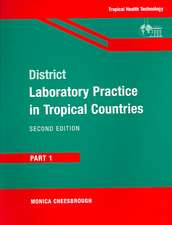Atlas of Histology of the Juvenile Rat
Editat de George A Parker, Catherine A. Picuten Limba Engleză Hardback – 26 mai 2016
While the histologic features of organs from young adult and aged laboratory rats are well known, less is known about the histologic features of organs from juvenile rats. Final histologic maturity of many organs is achieved postnatally, thus immature histologic features must be distinguished from chemical- or drug-related effects. While this postnatal organ development is known to exist as a general concept, detailed information regarding postnatal histologic development is not readily available. The Atlas includes organs that are typically sampled in nonclinical toxicology studies and presents the histologic features at weekly intervals, starting at birth and extending through postnatal day 42.
- Written and edited by highly experienced, board-certified toxicologic pathologists
- Includes more than 700 high-resolution microscopic images from organs that are typically examined in safety assessment toxicology studies
- Detailed figure legends and chapter narratives present the salient features of each organ at each time interval
- Figures are available for further study via Elsevier’s Virtual Microscope, which allows viewing of microscopic images at higher magnification
- Valuable resource for toxicologic pathologists who are confronted with interpretation of lesions in juvenile rats in situations where age-matched concurrent controls are not available for comparison, e.g., with unscheduled decedents
- Figures are available for further study on ScienceDirect with Virtual Microscope, which allows viewing of microscopic images at higher magnification
Preț: 970.05 lei
Preț vechi: 1218.06 lei
-20% Nou
Puncte Express: 1455
Preț estimativ în valută:
185.64€ • 201.58$ • 155.94£
185.64€ • 201.58$ • 155.94£
Carte tipărită la comandă
Livrare economică 16-30 aprilie
Preluare comenzi: 021 569.72.76
Specificații
ISBN-13: 9780128026823
ISBN-10: 0128026820
Pagini: 462
Dimensiuni: 216 x 276 x 28 mm
Greutate: 1.47 kg
Editura: ELSEVIER SCIENCE
ISBN-10: 0128026820
Pagini: 462
Dimensiuni: 216 x 276 x 28 mm
Greutate: 1.47 kg
Editura: ELSEVIER SCIENCE
Cuprins
Integumentary System, Including Mammary and Adnexal Glands
Lauren Staska
Musculoskeletal System
Jairo Nunes
Nervous System, Central and Peripheral
Amera Remick
Respiratory System
Melanie Greeley
Gastrointestinal System
Gary Coleman
Liver, Exocrine Pancreas and Salivary Glands
Danielle Brown
Reproductive System, Female
Catherine Picut
Reproductive System, Male
Catherine Picut
Endocrine System
Amera Remick
Immune System
George Parker
Hematopoietic System
Josely Figuieredo
Special Senses (Eye and Ear)
Gary Marit
Urinary System
Danielle Brown
Cardiovascular System
Melanie Greeley
Lauren Staska
Musculoskeletal System
Jairo Nunes
Nervous System, Central and Peripheral
Amera Remick
Respiratory System
Melanie Greeley
Gastrointestinal System
Gary Coleman
Liver, Exocrine Pancreas and Salivary Glands
Danielle Brown
Reproductive System, Female
Catherine Picut
Reproductive System, Male
Catherine Picut
Endocrine System
Amera Remick
Immune System
George Parker
Hematopoietic System
Josely Figuieredo
Special Senses (Eye and Ear)
Gary Marit
Urinary System
Danielle Brown
Cardiovascular System
Melanie Greeley
Recenzii
"Although this atlas is an essential resource for the toxicological community, it is also relevant for pathologists, veterinarians, and anatomists because of the tremendous detail, precise terminology, and excellent images, along with historical and contemporary references." --Journal of the American Veterinary Medical Association
"...an excellent reference to aid the pathologist in both proficiently recognizing distinguishing features of the juvenile rat compared to the adult and identifying possible developmental disturbances. This text will be useful to anyone interpreting pathology endpoints in studies using juvenile rats, whether in industrial or academic research." --Veterinary Pathology
"...an excellent reference to aid the pathologist in both proficiently recognizing distinguishing features of the juvenile rat compared to the adult and identifying possible developmental disturbances. This text will be useful to anyone interpreting pathology endpoints in studies using juvenile rats, whether in industrial or academic research." --Veterinary Pathology







